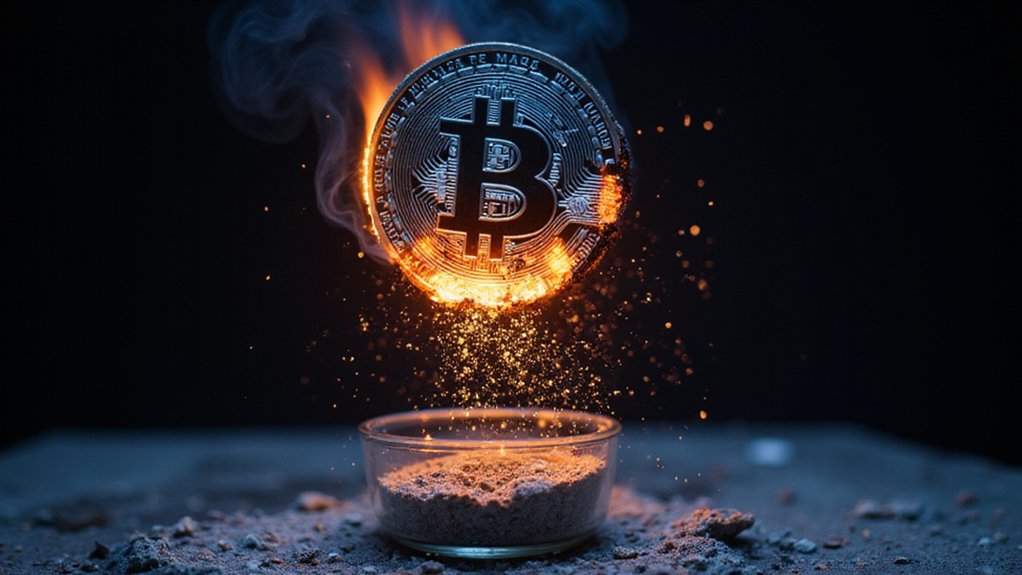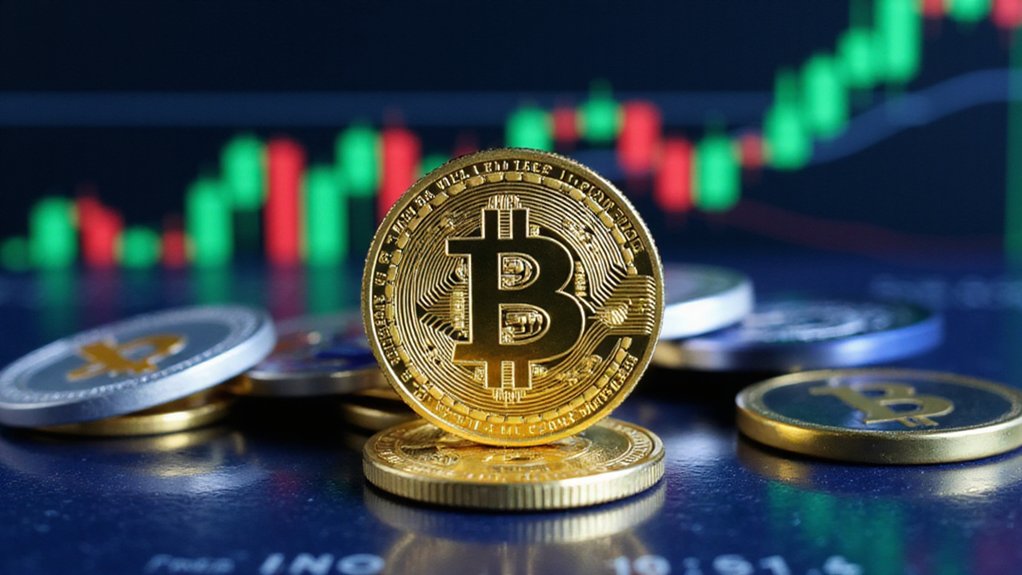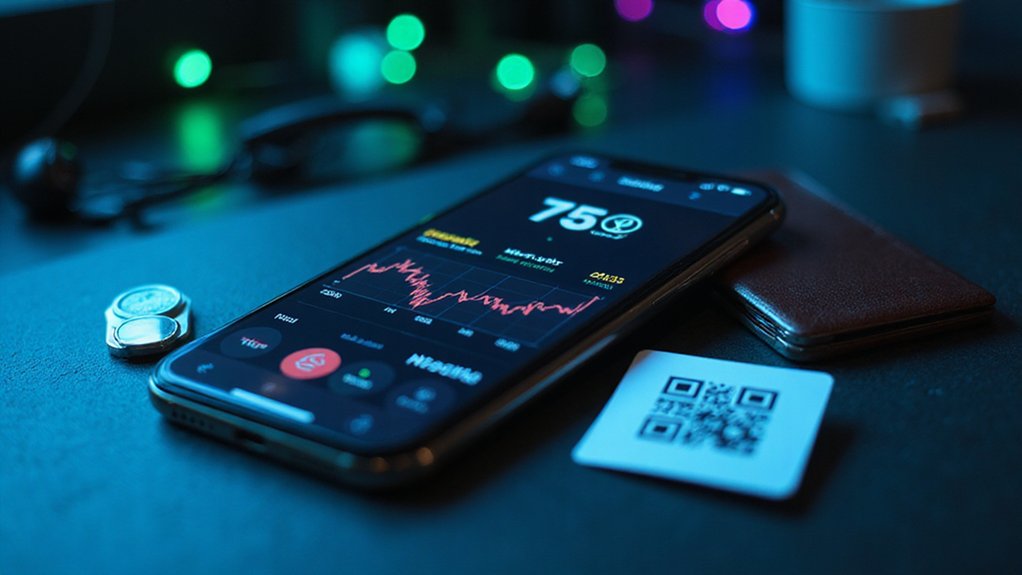Cryptocurrencies oscillate wildly due to an intricate dance of supply-demand mechanics, market sentiment, and regulatory developments. Bitcoin’s fixed cap creates programmatic scarcity, while tweets from tech luminaries can trigger buying frenzies or panic-selling overnight. Genuine utility drives sustainable valuations, though regulatory clarity (regardless of restrictiveness) often proves more valuable than favorable treatment. Macroeconomic factors—inflation concerns, monetary policy shifts—further complicate this volatile ecosystem. The forces at play extend far beyond simplistic market narratives.

Why do digital assets that exist merely as cryptographic code command market capitalizations rivaling multinational corporations, only to shed billions in value overnight?
The answer lies within the interplay of several fundamental factors, chief among them the delicate equilibrium between supply and demand.
Cryptocurrencies often feature capped total supplies—a programmatic scarcity that, when met with surging demand, propels valuations skyward.
Conversely, when selling pressure overwhelms purchasing interest, prices plummet with remarkable velocity, particularly in markets plagued by liquidity constraints.
Market sentiment exerts outsized influence on these digital assets, with prices oscillating in response to news cycles and social media narratives.
Cryptocurrency valuations dance to the erratic rhythm of tweets, headlines and collective sentiment—a digital mood ring for financial markets.
A single tweet from a tech mogul or whispers of institutional adoption can ignite euphoric buying frenzies, while security breaches or regulatory crackdowns precipitate panic-selling cascades.
This psychological dimension—where fear and greed reign supreme—explains why cryptocurrencies routinely exhibit volatility that would be considered pathological in traditional markets.
The practical utility and adoption trajectory fundamentally underpin long-term valuation models.
Cryptocurrencies demonstrating genuine usefulness—facilitating transactions, enabling decentralized applications, or providing governance mechanisms—typically sustain demand through market cycles.
Integration with mainstream financial infrastructure and commercial acceptance reinforces perceived legitimacy and bolsters price support levels.
Regulatory environments cast long shadows over cryptocurrency markets.
The patchwork of global approaches—from embrace to prohibition—creates jurisdictional arbitrage opportunities while simultaneously introducing compliance uncertainties that dampen institutional participation.
Clarity often proves more valuable than favorability; markets frequently rally on regulatory developments that merely provide certainties, regardless of restrictiveness.
Technological advancements similarly drive valuation shifts, with scalability improvements, energy efficiency innovations, and security enhancements attracting developer communities and users alike.
Meanwhile, macroeconomic conditions—inflation concerns, currency devaluations, and monetary policy shifts—increasingly correlate with cryptocurrency performance as these assets mature into alternative investment vehicles.
Bitcoin’s programmed scarcity, with its fixed cap of 21 million coins, represents the quintessential supply restriction mechanism that drives long-term price appreciation despite short-term volatility.
Even with Bitcoin’s capped supply, the reality of lost coins due to forgotten private keys means the actual circulating supply is permanently lower than the theoretical maximum, potentially enhancing scarcity value.
In this intricate ecosystem, cryptocurrencies remain simultaneously revolutionary financial instruments and speculative vehicles, their prices reflecting both technological promise and human psychology.
Frequently Asked Questions
How Do I Protect My Cryptocurrency Investments During Market Volatility?
To protect cryptocurrency investments during market volatility, investors should diversify across multiple assets, employ cold storage for security, and consider dollar-cost averaging rather than panic selling.
Asset protection structures like LLCs provide legal shields, while multi-signature wallets prevent impulsive transactions.
Stablecoins offer temporary havens during extreme turbulence.
The judicious deployment of stop-loss orders—those digital safety nets for the anxiety-prone—can prevent catastrophic losses when markets inevitably gyrate between irrational exuberance and existential despair.
Can Government Regulations Predict Cryptocurrency Price Movements?
Government regulations cannot definitively predict cryptocurrency prices, though they function as significant market signals.
Regulatory announcements—whether crackdowns or favorable frameworks—typically trigger immediate market responses, with restrictive measures generally depressing values while clarity often boosts them.
The correlation, however, isn’t deterministic; markets occasionally defy expected reactions based on contradictory signals from multiple jurisdictions or when regulations get priced in beforehand.
Sophisticated investors monitor regulatory developments as one factor within a broader analytical framework.
What Role Do Celebrity Endorsements Play in Cryptocurrency Values?
Celebrity endorsements function as double-edged catalysts in cryptocurrency markets.
They greatly amplify initial fundraising and exchange listings while triggering volatile price movements—sometimes spectacularly so, as with Ethereum’s 24-hour leap from $2,300 to $2,900 following a high-profile endorsement.
However, these star-powered surges typically generate ephemeral hype rather than sustainable value.
The celebrity effect creates a “rollercoaster” pattern where fundamentals take a backseat to fame, potentially concentrating token ownership and increasing fraud susceptibility among emotionally-driven investors.
How Do Blockchain Upgrades Affect Cryptocurrency Prices?
Blockchain upgrades fundamentally alter cryptocurrency prices through multiple vectors of influence.
These technical enhancements—whether addressing scalability, security, or functionality—typically generate pre-implementation speculative surges followed by potential “sell the news” corrections.
Successful deployments that deliver tangible improvements in transaction costs, throughput, or developer experience often sustain longer-term appreciation, while botched upgrades can trigger precipitous declines.
The market’s reaction ultimately hinges on whether the upgrade’s reality aligns with or exceeds the community’s expectations.
Are Cryptocurrency Prices Correlated With Traditional Financial Markets?
Cryptocurrency prices increasingly exhibit correlation with traditional markets, though the relationship remains dynamic.
Institutional involvement has strengthened these connections, with crypto assets often moving alongside equities—particularly during market stress events.
The correlation coefficient between Bitcoin and the S&P 500 has fluctuated historically, strengthening during pandemic-era liquidity crises and recent interest rate cycles.
Notably, cryptocurrencies display inverse relationships with fear indices like VIX, suggesting they’re not quite the “digital gold” safe haven some proponents claim.









